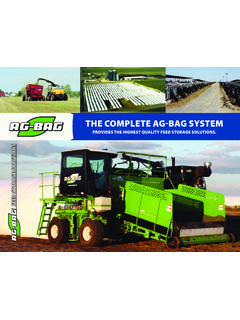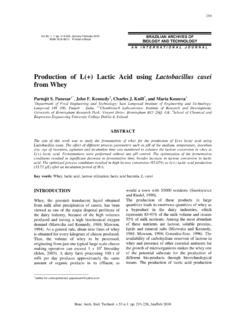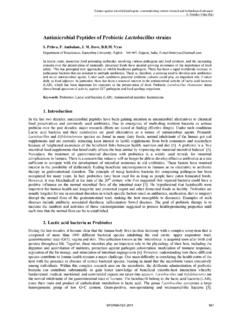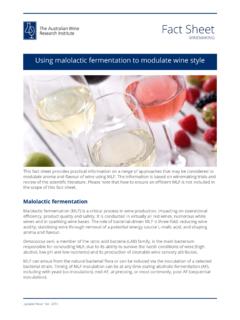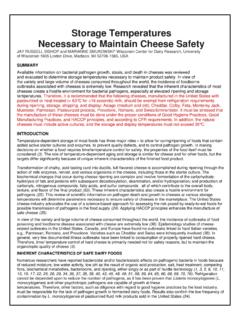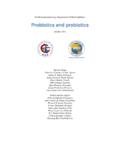Transcription of The 3M’s of Silage - Ag-Bag Systems
1 MANAGEMENTMATURITYM oistureThe 3M s of Silage2 THE 3M S OF SILAGEA ppendix BAg-Bag International, of Contents3M S OF Ag-Bag #1 MANAGEMENT ..33M #2 MATURITY ..8 SUGGESTED DAILY FEED OUT RATES ..10 CUT CROP AT THE PROPER STAGE OF MATURITY .. 113M #3 MOISTURE ..13 DAIRY TERMS TO KNOW ..15 DAIRY TERMS TO KNOW .. 3M S OF SILAGEA ppendix B Ag-Bag International, s of Ag-Bag SILAGEThe 3M s of Ag-Bag Silage representdocumented methods and technology of goodsilage making.
2 Ensiling has proven to be the mostefficient method of storing and preserving thenutrient value of your crops. We invite you to benefitfrom proven methods and profit-making on, it can change your ART OF MAKINGEXCELLENT SILAGE1. Silage making is a science, that incorporatesgood management practices. Although manyfactors affect the profitability of a farming operation,forage quality is definitely on of the most It s an accepted fact that rapidly fermented, highmoisture feed retains a higher nutrient value thanany other method of harvesting and storing By understanding the basics of the fermentationprocess and using good management practices,you can aid nature in achieving a rapid, efficientfermentation, which preserves more of the valuablenutrients in your forage By learning how to consistently make excellentsilage.
3 (The Silage referred to in this publication isfermentable feed compacted and stored in anairtight Ag-Bag bag) it can lead to a greaterproduction of meat and A good anaerobic fermentation improves thepalatability of feed. The fermentation process usingthe Ag-Bag system is very similar to the digestionprocess in the first stomach of cattle. Wellfermented silages are a natural feed for cattle. It svery much like putting your animals on greenpasture year quality of Silage is largely determined by threethings:DedicationPreparationExecuti on3M #1 MANAGEMENTTHE SOILThe soil should be fertile and pH balanced to insuregood germination.
4 Good soil management alwaysproduces the highest quality SEEDSHigh quality seed designed to produce well in yourarea, for length of season and weatherconsiderations are a must. You can t produce cropsany better than the seeds you ENSILING PROCESS Silage is a feedstuff resulting from thepreservation of green forage crops by is the result of the fermentation of theforage in the absence of oxygen. Research hasproven conclusively that the process of ensilinggreen crops is the most efficient method of storingand preserving the nutritional value of crops forfeeding to ruminant animals. The breaking downof the cellulose and lignin of the plant cells byfermentation helps make the forages moredigestible, thus producing more value.
5 In somecases, the forages are more digestible than greenfeeding or pasturing . All types of forages can befermented and successfully miracle of fermentation starts with thebacterias enzymes sugars proteins and anoxygen-free Respiration When a forage plant is harvestedand placed in an Ag-Bag bag it is alive andtherefore, respiring actively. Even though theforages are packed extremely tight some air isunavoidably trapped in the mass. The oxygen isutilized by the aerobic bacteria existing in the crop,and by the breakdown of sugar in the plant Aerobic fermentation This phase of theensiling process is called aerobic respiration.
6 Endproducts of this phase of the process are carbondioxide and heat. These reactions are notcomplete and other end products are produced4 THE 3M S OF SILAGEA ppendix BAg-Bag International, as acetic and butyric acids later used bylactobacilli and streptococci to produce lactic enzymes from the plant are also activein this phase, and they break down some of theplant proteins into amino acids. This phase ofrespiration is complete when the oxygen in themass is completely depleted, and the action of theanaerobic microorganisms begin. Aerobicrespiration lasts from 5 to 10 hours under goodstorage fermentation STARTSP hase 1 This is a relatively short phasecharacterized by the beginning of anaerobicmicroorganism activity.
7 The cell contents diffuseout of the cell due to the chopping of the plant, andare used by bacteria clinging to the plant whenplaced in the bag. The formation of acetic andbutyric acids are characteristic of this phase. Thelife of organisms producing these acids is shortdue to the drop in pH produced by their own 2 This phase is the initiation of the lacticacid fermentation . This activity is well underway atthe end of three days and the establishment of thisactivity completes Phase 3 Lactic acid production is continued inthis phase and reaches it s peak which should - percent of the dry matter and a pH thatis constant at about No further changes occur,and the Silage is fermented if the pH remainsbetween and for corn Silage , and for other crops, and no air is allowed to enterthe 4 This is a stage of quiescence orinactivity.
8 The material has a pH of - and ifwater and oxygen remain excluded, no furtherchemical changes occur and the material willremain in this preserved state almost 5 This is an undesirable phase. If the pHdoes not drop below approximately , or if air isallowed to enter the Silage , butyric acid productionis initiated, converting the soluble carbohydratesand lactic previously formed to butyric acid whichis characteristic of spoiled Silage . Also, proteinsare broken down to amino acids and these arefurther degraded to other nitrogenous compounds,which may lead to a reduction in a level of AND INOCULANTSThe general knowledge of the biochemistry andmicrobiology of Silage fermentation has increasedtremendously in the last 25 years.
9 Silage is aproduct of anaerobic fermentation . It involves theconversion of water soluble carbohydrates(sugars) to lactic acid, which drops the pH to alevel sufficient to inhibit any further biological activity(change) in the ensiled material when maintainedunder anaerobic most circumstances, good Silage is achievedby encouraging the dominance of lactic acidbacteria (the good guys), and discouraging theactivity of clostridia and yeast ( the bad guys). Inthe initial stages of ensiling, plant respiratoryenzymes (bad ones) oxidize solublecarbohydrates, resulting in heat production anddecreased amount of sugars available OF ENSILINGA erobic phase.
10 As crops are put into the bags,two things start to happen: respiration andproteolysis (enzyme action), which are attributedto the activities of plant enzymes. Respiration isthe complete breakdown of a substance to carbondioxide and water, using oxygen. Harvesting of theforage crushes and chops the plant, damaging thecells and releasing many plant enzymes. Some ofthe enzymes, amylase and hemicellulase, breakdown starches, increasing the level of sugars inthe plant. Of these processes, respiration is mostdetrimental to Silage quality because:1. Respiration causes a loss of dry The plant uses up existing plant sugars duringrespiration.

